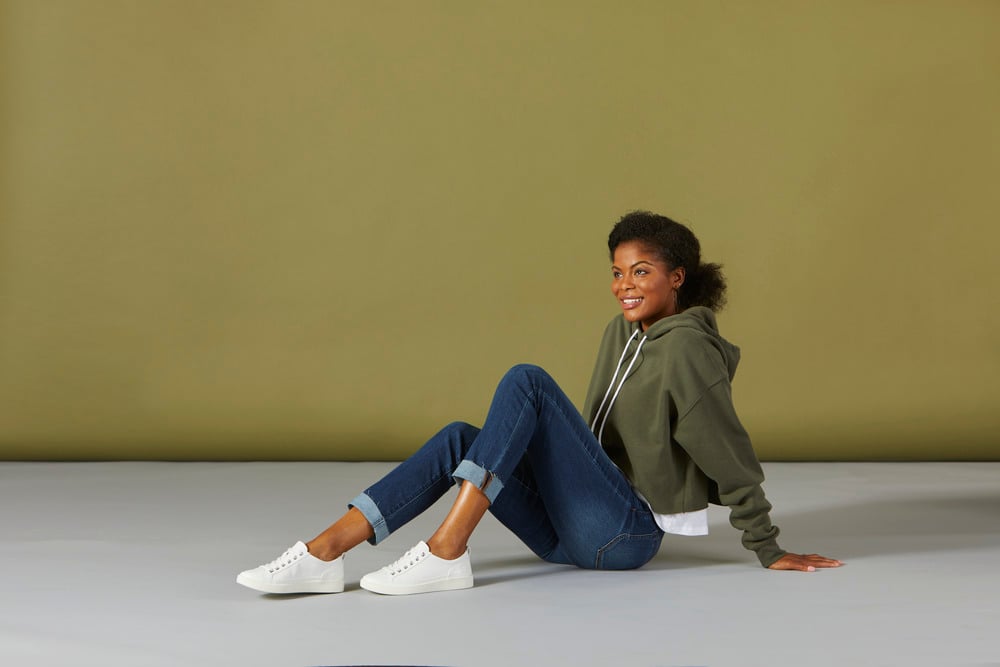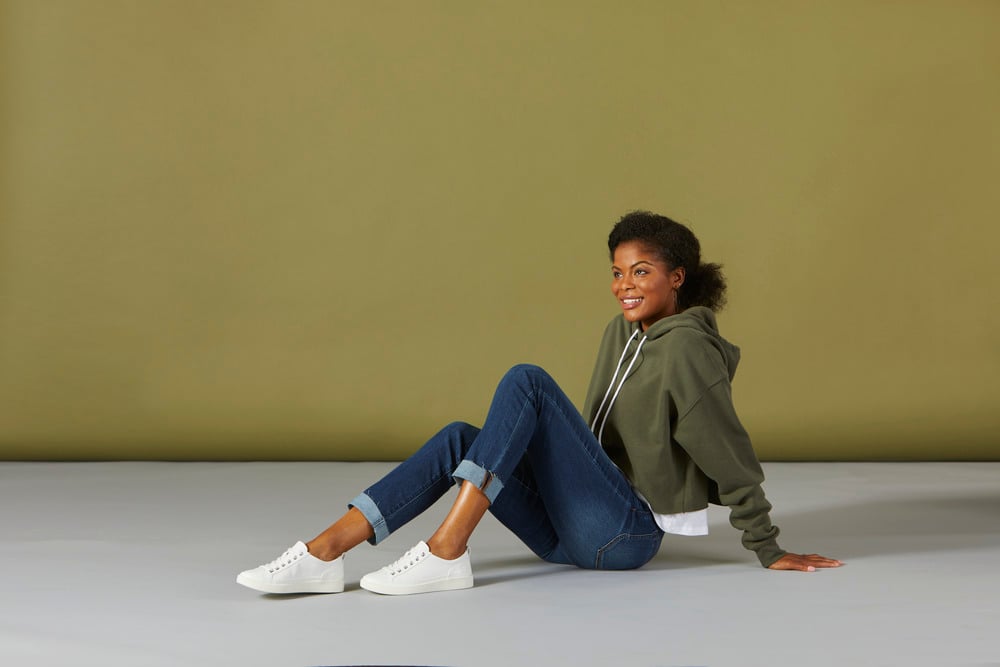
But what are tennis shoes exactly, why are they called tennis shoes, and are they any different from the comfortable shoes we call sneakers? Read on for answers to these questions from the footwear experts at Vionic.
What Is a Tennis Shoe?
A tennis shoe is essentially a lace-up shoe with vulcanized rubber soles and lightweight uppers, typically made of canvas or another textile. In the modern world, the word tennis shoe is all but synonymous with sneaker, though some people will argue that they’re distinctly different.
Also called athletic shoes, running shoes, trainers, gym shoes, track shoes, court shoes, or sport shoes, the active footwear category was traditionally intended for playing sports, working out, or maintaining an otherwise physically active lifestyle.² However, today’s tennis shoes are often worn with street clothes and everyday wear.
Why Is It Called a Tennis Shoe?
Before tennis shoes came to market, canvas shoes with rubber outsoles were called plimsolls.³ However, the tennis shoe was named the tennis shoe because it was first designed for people who play—you guessed it—tennis.²
During the turn of the century and throughout the early 1900s, as the sport gained popularity, the footwear style was developed to provide stability and support while keeping the tennis player comfortable on the clay court.² As such, these shoes featured substantially more support than the original plimsolls.
What Makes a Tennis Shoe a Tennis Shoe?
To qualify as a proper tennis shoe, a shoe should have a rubber sole for flexibility, shock absorption, and support, along with canvas (or another type of textile) uppers for breathability. Unlike pumps and dress shoes, it’s generally a flat-soled and lightweight shoe.
Nowadays, tennis shoes can be used to describe almost any type of active footwear, aside from athletic sandals. In fact, whether you call them tennis shoes, sneakers, or trainers likely depends on where you live.
For instance, aside from the Northeast and Florida, most people throughout the U.S. use the word tennis shoes when referring to athletic footwear. On the other hand, Europeans are more likely to call them trainers.⁴
History of Tennis Shoes
While the athletic shoe didn’t become popular until nearly a century later, active shoes with rubberized soles have actually been around since the mid-1800s. Here’s what to know about the history and evolution of the sneaker.
First Iterations
As noted above, the first canvas shoes with rubber soles were called plimsolls. This sports shoe was originally worn by vacationers and the leisure class, though it quickly caught the attention of tennis and croquet players.⁵ To provide adequate grip in addition to support, the rubber outsoles of plimsolls were eventually engraved with patterns.
First Running Shoes and Basketball Shoes
Featuring spiked soles for speed and traction, the first running shoes came to market in the late 1800s. In the early 20th century, these active shoes were ordered for Olympic track teams throughout Europe.⁵ Around the same time, the world’s first basketball shoes were created— though they wouldn’t have their moment in the spotlight until the second half of the century.
The Popularization of Tennis Shoes
Following World War II, when watching professional sports became a more common pastime, the American tennis shoe market continued to grow. In the 1950s, when leisure activities expanded and school dress codes began to relax, kids and teens started wearing sneakers not just for sports but for casual wear.
Additionally, jogging, tennis, and aerobics became popular pastimes for adults, who needed the proper shoe. Thanks to trailblazing brands like Spalding, Converse, and Nike, the popularization of sneakers boomed globally during the second half of the 20th century.
Modern Tennis Shoes
In the 1990s and early aughts, active shoes were at the forefront of mainstream fashion. Brands started getting endorsements from professional athletes, and wearing the newest styles became the ultimate form of self-expression.⁶
In 1998, 285 tennis shoe models came to market—a sharp increase from only five in 1970. And in 2012, there were nearly 3,500 new sneakers available for purchase.⁷
Modern tennis shoes include a broad range of styles. From running shoes, walking shoes, and cross-trainers to fashion sneakers, high-tops, and slip-ons, there’s something for everyone and every activity.
Tennis Shoes vs. Sneakers
Lots of folks wonder about the difference between tennis shoes vs sneakers. Historically, tennis shoes were designed for playing tennis, as they offered traction and stability on grass or clay courts. And technically speaking, the world’s first running shoes and basketball shoes for hard courts appeared a few decades later.
On account of the flexible rubberized soles, you could literally sneak around without making a sound while wearing active shoes, hence the name sneakers. But as mentioned above, today’s tennis shoes and sneakers are generally considered to be the same thing.
Types of Tennis Shoes
There are several types of tennis shoes for men and women. If you’re looking to pair the perfect outfits with tennis shoes, here are the most common types:
- Low-top lace-ups
- Slip on sneakers
- Bungee-lace shoes
- Walking shoes
- Running shoes
- Basketball shoes
- Cross-trainers
- Fashion sneakers
- Slip-resistant work shoes
- Mary Janes
- Sneaker booties
- Sneaker wedges
- Platform sneakers
Vionic is proud to carry on-trend tennis shoes for casual dress, along with active sneakers and anti-slip styles to wear on the job.
What Are the Best Tennis Shoes?
The best tennis shoes are lightweight and flexible yet supportive and sturdy. Whether you’re walking to the office, out for a jog, clocking in at work, or just hanging out on the weekend, the right shoe should offer adequate arch support.
With this in mind, women’s and men’s tennis shoes with arch support feature the same podiatrist-designed orthotic footbeds as our APMA-accepted shoes. The contoured engineering provides not only the support you need but also stability and cushioning underfoot. Explore our APMA-accepted women’s shoes and APMA-accepted men’s shoes for unparalleled comfort and support on every step.
What Are the Most Comfortable Tennis Shoes?
The most comfortable tennis shoes are styles with ample support and durable outsoles. Vionic’s active footwear for men and women is designed with our proprietary Vio-Motion Support technology.
This means each pair is embedded with deep heel cups, crave-worthy arch support, and whole-foot stability. Not only that, but our sturdy rubber outsoles are designed to offer long-lasting durability and traction underfoot.
If you think wearing comfortable tennis shoes means you’ll have to sacrifice fashion, think again. The styles from Vionic are always on-trend, and the orthotics are concealed within the soles of each shoe.
Shop our tennis shoe collections today!
External Sources:
- Tim Newcomb. “The evolution of tennis shoes: From plimsolls to Stan Smiths and Nikes”. SI. Nov 18, 2015. https://www.si.com/tennis/2015/11/18/tennis-shoes-stan-smith-john-mcenroe-pete-sampras
- Kent van Alstyne. “Difference Between Tennis and Running Sneakers”. Live strong. Jul 12, 2019. https://www.livestrong.com/article/502869-difference-between-tennis-and-running-sneakers/
- Plimsoll. Cambridge Dictionary. https://dictionary.cambridge.org/us/dictionary/english/plimsoll
- Walt Hickey. “22 Maps That Show How Americans Speak English Totally Differently From One Another”. Business Insider. Jun 5, 2013. http://www.businessinsider.com/22-maps-that-show-the-deepest-linguistic-conflicts-in-america-2013-6?op=1
- “The History of the Sneaker”. The Washington Post. https://www.washingtonpost.com/archive/lifestyle/2002/05/14/the-history-of-the-sneaker/aa2096d1-a7e2-4427-a324-cb603512722d/
- Stephen M. Pribut and Douglas H. Richie. “2002: A Sneaker Odyssey”. Dr. Stephen M. Pribut’s Sport Pages. https://www.drpribut.com/sports/sneaker_odyssey.html
- Aichner, T., Coletti, P. Customers’ online shopping preferences in mass customization. J Direct Data Digit Mark Pract 15, 20–35 (2013). https://doi.org/10.1057/dddmp.2013.34
- “Tennis shoes”. Encyclopedia. Updated may 21, 2018. https://www.encyclopedia.com/sports-and-everyday-life/fashion-and-clothing/clothing-jewelry-and-personal-adornment/tennis-shoes
- “The History of the Modern Tennis Shoe”. Did you know fashion. https://didyouknowfashion.com/the-history-of-the-modern-tennis-shoe/
